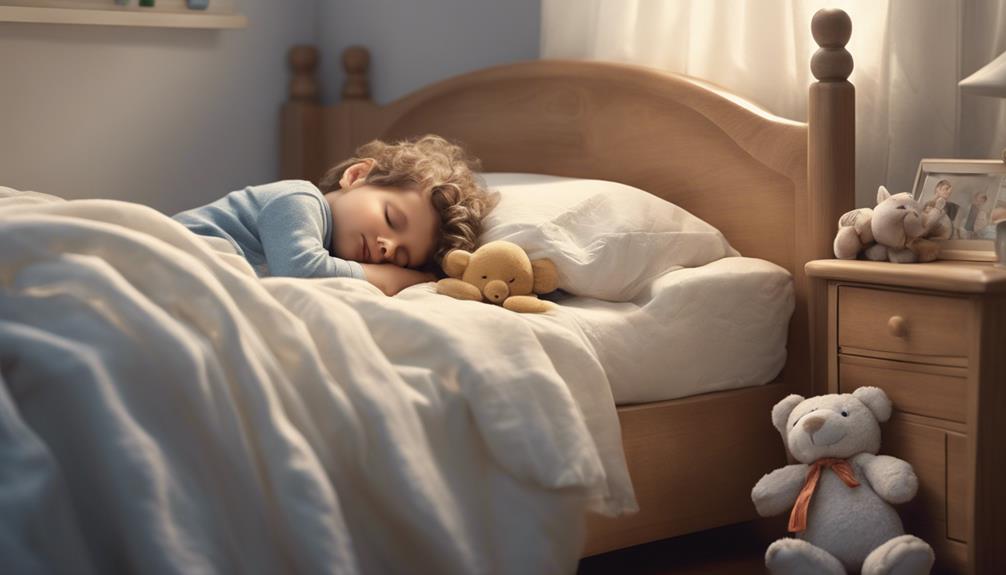Stepping into the new routine of sleeping in a parent’s bed after divorce can bring about challenges for children. However, do not worry, as we will discuss effective strategies to help with this adaptation.
From fostering consistent routines to fostering open communication, there are key steps to consider. Join us as we unravel practical tips and insights to help children acclimate to this shift with grace and understanding.
Key Takeaways
- Open communication about new sleeping arrangements is crucial for a smooth transition.
- Creating a cozy independent sleeping space can help children adjust.
- Setting clear expectations and bedtime rules establishes boundaries.
- Consistent bedtime routines aid in children's adaptation to co-sleeping.
Effects of Divorce on Children's Sleep
Experiencing the stress of divorce can disrupt children's sleep patterns, leading to difficulties falling asleep and staying asleep. The emotional impact of divorce on children can manifest in various sleep disturbances like insomnia, nightmares, bedtime anxiety, or sleep-onset association disorder.
These disruptions can be challenging for both the children and parents involved. Consistency in bedtime routines across both parents' homes post-divorce is crucial for helping children adjust and improve their sleep. Children thrive on predictability and stability, especially during times of significant change like divorce.
Seeking professional guidance for children experiencing sleep problems after divorce can provide valuable insights and strategies to address their specific needs and concerns. By prioritizing a supportive and structured bedtime routine, parents can create a comforting environment that promotes better sleep habits for their children, ultimately aiding in their adjustment to the changes brought about by divorce.
Coping Strategies for Co-Sleeping

When navigating the transition from co-sleeping to independent sleeping after divorce, establishing clear boundaries and consistent bedtime routines can be key strategies to support children's adjustment. Here are some coping strategies to help ease this transition:
- Communicate openly: Talk to your child about the upcoming changes, explaining the reasons behind establishing new sleeping arrangements. Reassure them of your love and support throughout the process.
- Create a cozy space: Make their independent sleeping area inviting and comfortable by incorporating familiar objects like their favorite stuffed animals or blankets to provide a sense of security.
- Set expectations: Clearly outline the new bedtime routine and rules surrounding sleeping arrangements. Consistency is crucial in helping children adjust to the change.
- Use positive reinforcement: Praise your child for their efforts in adapting to independent sleeping. Encouragement can boost their confidence and make the transition smoother.
Promoting Healthy Sleep Habits
To promote healthy sleep habits for children adjusting to new sleeping arrangements post-divorce, caregivers can play a crucial role in establishing consistent bedtime routines that foster stability and comfort. Kids thrive on predictability, so creating structured routines around bedtime can provide a sense of security during this period of adjustment. Involving the child in setting up a peaceful sleep environment can also help alleviate any anxiety they may be experiencing about sleeping in a new place. By ensuring that both homes have relaxing bedrooms tailored to the child's preferences, caregivers can enhance the quality of their sleep and overall comfort.
Consistency is key when it comes to helping children develop healthy sleep habits post-divorce. Managing different bedtime routines between households while maintaining a similar structure can aid in the adjustment process and help kids feel secure in their new sleeping arrangements. By prioritizing the establishment of calming bedtime rituals and a soothing sleep environment, caregivers can support children in getting the peaceful sleep they need to navigate this transitional period successfully.
Establishing Boundaries and Routines

Establishing clear boundaries and consistent routines around sleeping arrangements post-divorce is essential for promoting a sense of security and independence in children. When it comes to helping children adjust to sleeping in their own bed after a divorce, setting up structured bedtime rituals and rules can make a significant difference.
Here are some key strategies to consider:
- Set boundaries: Clearly define when and where the child will sleep to create a predictable environment.
- Establish bedtime routines: Consistent routines in both parents' homes can help children transition smoothly to sleeping in their own bed.
- Enforce rules and expectations: Having clear rules around bedtime behavior reinforces the importance of healthy sleep habits.
- Create personalized routines: Encouraging children to have a special bedtime routine in each home can make the transition process comforting and unique.
Seeking Professional Help
Navigating the challenges of helping children adjust to sleeping in their own bed after a divorce can be complex, especially when addressing emotional needs post-separation. Seeking professional help from therapists specializing in child psychology is crucial in providing the necessary guidance to support your child through this adjustment period.
Therapists can offer valuable insights into coping mechanisms for separation anxiety and sleep issues that may arise post-divorce. Their expertise can assist in implementing strategies that promote emotional well-being and help establish healthy routines for your child.
Frequently Asked Questions
At What Age Is a Child Most Affected by Divorce?
We understand that the impact of divorce on children is most pronounced between ages 3 to 5. This age group may struggle with changes in sleeping arrangements, experiencing separation anxiety and seeking comfort in parental presence.
How Long Does It Take for Kids to Adjust to Divorce?
We understand the struggles children face when adjusting to divorce. Factors like age, temperament, and support influence the timing. It typically takes 6 months to 2 years. Therapy and consistency play vital roles in helping kids adapt.
How Do I Help My Child Transition Between Divorced Parents?
Transitioning between divorced parents can be challenging for kids. We suggest open communication, consistency in routines, and involving the child in solutions. Research shows children thrive when given a sense of control and understanding in these situations.
At What Age Should a Child Stop Sleeping in the Same Bed With the Parent?
As parents, we understand the importance of establishing healthy sleep habits for our children. Encouraging independence in sleeping fosters autonomy. Boundaries and consistent routines aid in transitioning kids out of co-sleeping arrangements, promoting their well-being.
How Can Establishing a Regular Sleep Schedule Help Children Adjust to Sleeping in Parents’ Bed After Divorce?
Establishing a regular sleep schedule can aid children’s coping after divorce. Following a consistent routine helps create a sense of stability and security, making it easier for children to adjust to sleeping in their parent’s bed. Enrolling them in activities like a children’s coping class schedule can also provide additional support during this challenging time.
Conclusion
In conclusion, by understanding the effects of divorce on children's sleep, implementing coping strategies for co-sleeping, promoting healthy sleep habits, establishing boundaries and routines, and seeking professional help when needed, we can support children in adjusting to sleeping in parents' bed after divorce.
Together, we can create a peaceful and secure sleep environment for our children, helping them feel safe and at ease during this challenging transition.










